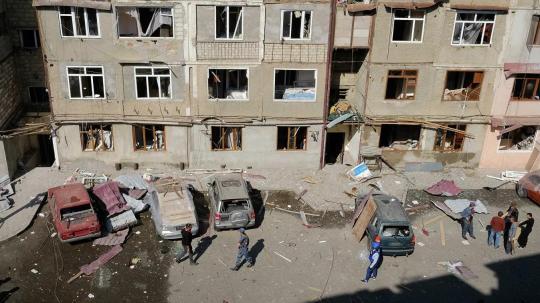Original Title: Day 8 of the Naka Conflict: The regional capital was shelled, and the two sides accused each other of attacking civilians
The conflict between Armenia and Azerbaijan in the Nagorno-Karabakh region has lasted for 8 days.
According to Russian media sources, on October 4, the two sides continued to fight. After the leader of the Naka region, Arutyunyan, ordered to stop missile attacks on military installations in Ganja, Azerbaijan, the two sides temporarily suspended the fire.
Azerbaijan later shelled the city of Stepanakert, the capital of the Nagorno-Karabakh region, causing the city's communications and power to be interrupted, and citizens were forced to hide in air defense fortifications.
The Azerbaijani side claimed that Arutyunyan, who went to the front in person, was injured, but the Asian Defense Ministry refuted the news.
City of Stepanakert.
The two sides accused each other of attacking civilians and civilian facilities.
Azerbaijan’s Attorney General said that Armenia’s attack on Azerbaijan resulted in 25 civilian casualties and 111 civilian casualties.
According to the Armenian Ministry of Defense, the Azerbaijani attack resulted in the death of 18 civilians in the Naka region and more than 90 wounded.
The two sides have not yet responded to the other side's statement.
On the same day, Azerbaijani President Aliyev stated that the Azerbaijani army captured a total of 10 cities and villages.
Aliyev also emphasized that the Naka conflict should be resolved through dialogue, but the premise for the ceasefire on the Arab side is that the Armenian side clarifies the timetable for the withdrawal of the Asian armed forces from the Naka region.
The Asian side should officially recognize the integrity of the Afghan territory.
Armenian Foreign Minister Mnatsakanyan and Russian Foreign Minister Lavrov have a phone call regarding the Naka conflict.
Both sides expressed serious concern about the increase in civilian casualties and reiterated that the political and diplomatic channels for conflict resolution should be restored as soon as possible under the coordination of the co-chairs of the OSCE Minsk Group.
Azerbaijan and Armenia have exchanged fire in the Nagorno-Karabakh region since September 27, accusing each other of initiating a new round of conflict. The armed conflict is still continuing. The Naka region is located in southwestern Azerbaijan, covering an area of 4,400 square kilometers. It was an autonomous prefecture of Azerbaijan during the Soviet period, and most of its residents were Armenians. In 1988, Naka requested to be incorporated into Armenia, which led to an armed conflict between the Afghan and Asian ethnic groups in the state. After the disintegration of the Soviet Union, a war broke out between Azerbaijan and Armenia in order to compete for Naka. Armenia took control of Naka and the surrounding parts of Azerbaijan. In 1992, under the initiative of Russia, the Conference on Security and Cooperation in Europe (the predecessor of the OSCE) established the Minsk Group of 12 countries, with Russia, the United States and France as the co-chairs. Since then, negotiations on the Naka issue at different levels have been held within the framework of the Minsk Group, but no substantial progress has been made. In 1994, Azerbaijan and Armenia reached an agreement on a comprehensive ceasefire, but the two countries have always been in a state of hostility over the Naqqa issue, and conflicts have occurred from time to time. (Headquarters reporter Song Yao)

